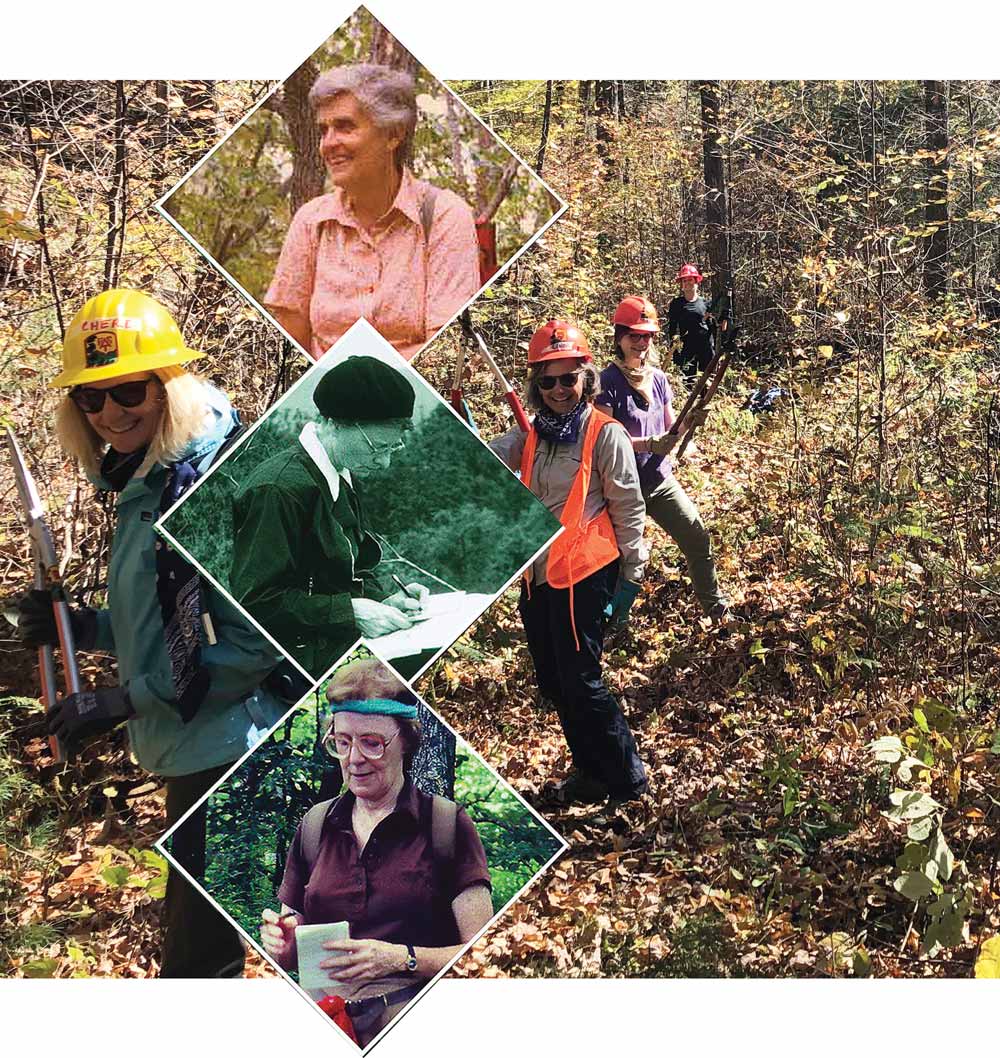By Anne Sentz, ATC Philanthropy Manager
We Were There, Too
March 12, 2021
The article below was originally published in the Winter 2021 issue of A.T. Journeys magazine. We are broadly sharing this and other select articles from this issue.
The Overlooked Stories of Three Women
I do not believe it is by accident that I finished my copy of We Were There, Too by Gwenyth L. Loose right around the time our nation inaugurated its very first female Vice President. As I read about three women whose efforts were vital to the success of the Appalachian Trail project, Loose’s writing elicited strong emotion. These stories needed to be told and heard. Feelings of pride, intermingled with sentiments like, “finally,” coursed through me.
We Were There, Too was published by the Appalachian Trail Conservancy (ATC) in late November 2020, so it is new to bookstores — and it deserves a place on your own shelf. The book is a quick and engaging read that spans ten decades of female leadership within the Trail community. Yet readers should take away more from this book than an important history lesson. Loose’s writing is a deep dive into the lives of women who deserve as much recognition as Benton MacKaye and Myron Avery. Yes, those two men are at the top of the list of the dreamers and doers who made the Trail a reality, but as the title of the book implies, there are other names Trail enthusiasts should know. We Were There, Too highlights three extraordinary women: Jean Stephenson, Ruth Blackburn, and Margaret Drummond.
Jean Stephenson is best known for founding and editing Appalachian Trailway News, an important communications tool established by the ATC (then the Appalachian Trail Conference) to inform, educate, and inspire. Stephenson also edited the first two generations of Trail guidebooks, but her skills went beyond writing and editing. She worked alongside Myron Avery to ensure the A.T. project had a strong organizational foundation, and by the time of her death in 1979, she had served in crucial positions in both the ATC and the Potomac Appalachian Trail Club (PATC). We Were There, Too makes it clear to readers that the Trail would not be what it is today without the efforts of Stephenson. Loose quotes Gannon Coffey, then-president of the Georgia Appalachian Trail Club, who wrote in August 1963: “Without Jean in her key position, we’d all be floundering around.”

Wild East Women (WEW) — an ATC affinity group working to support women in engaging with the Trail in meaningful ways — clear vegetation on Jerry’s Run Trail during a WEW Trail Maintenance Day in 2020 at Ramsey’s Draft Wilderness in Augusta County, Virginia. –Photo courtesy of WEW; Inset from top: Trail Pioneers Ruth Blackburn, Jean Stephenson, and Margaret Drummond
Loose’s writing is a deep dive into the lives of women who deserve as much recognition as Benton MacKaye and Myron Avery. Yes, those two men are at the top of the list of the dreamers and doers who made the Trail a reality, but as the title of the book implies, there are other names Trail enthusiasts should know.
While Stephenson’s passion for the A.T. burned brightly from the start, by contrast, Ruth Blackburn slowly fell in love with the Trail. In fact, she described her first hike as “gosh-awful.” Once she embraced her enthusiasm, though, it resulted in a lifelong dedication to the A.T. until her death in 2004 at the age of 96. Blackburn is known for her work to secure a protected Trail corridor, and she devoted years to researching private land ownership along the A.T. Eventually becoming president of PATC, she was recognized as an expert in land ownership from Virginia to Pennsylvania. Blackburn went on to become chair of the ATC from 1980 to 1983, which was a crucial time for land acquisition because of federal mandates to complete a continuous Trail and a protected corridor.
Like Blackburn, Margaret Drummond ultimately became chair of the ATC in 1989. She held the position for six years. She came into her position at ATC having been president of the Georgia Appalachian Trail Club (GATC), so she carried a unique regional perspective that influenced her views on the national level. Drummond worked to affirm and reaffirm tireless Trail volunteers, focusing their attention on the enormous responsibility of maintaining the A.T. in the wake of new responsibilities authorized under the National Trail Systems Act. She was able to create enthusiasm within the volunteer corps while also underscoring the importance of skill standardization — and it was not easy, because the transition to a cooperative management system that included the federal government was not always readily embraced.
In the introduction to We Were There, Too, Loose describes the feeling of “wide-eyed wonder” she experiences when she is first introduced to the A.T. as a young child. The same could be said of me, too, as I read her book. I was reminded to be grateful for those women who have paved the way for so many of us to protect, maintain, and advocate for the Appalachian National Scenic Trail. I will think of Jean when I write a piece for A.T. Journeys, which is the successor to Appalachian Trailway News; I will remember Ruth when I talk to ATC partners about new and exciting landscape conservation opportunities; and I will recall Margaret’s memory the next time I see the historical marker at the beginning of the Approach Trail in Georgia’s Amicalola Falls State Park. I will carry the spirit of those women — and all others — who have dedicated so much to the A.T. and its preservation. We Were There, Too, and as Loose so eloquently maintains: we will continue to be here, now and into the future.
Purchase a copy of We Were There, Too from Mountaineer Books at appalachiantrail.org/we-were-there-too
